
Archery.
Sketched Etched & Published by George Cruikshank. [n.d., c.1835.]
Etching on india laid paper, 190 x 280mm. 7½ x 11".
Eight vignettes, featuring female hairstyles, the largest showing putti in an archery tournament. A satirical print from 'My Sketch Book' 1834 by George Cruikshank (1792 - 1878).
[Ref: 12017] £65.00
(£78.00 incl.VAT)
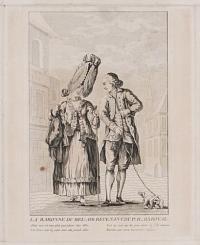
La Baronne du Bel-Air Revenant du Palais Royal.
[French, c.1775.]
Etching with very large margins, 290 x 190mm (11½ x 7½" ) with four lines of text in French underneath. Paper lightly toned, stained, folds in margins.
A woman wearing a bonnet like a scallop shell, taking to a man with a small dog on a lead. 'La Baronne du Bel-Air' was a one-act opera. Ex Collection of the Hon Christopher Lennox-Boyd.
[Ref: 31746] £260.00
(£312.00 incl.VAT)
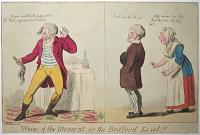
Whims of the Moment or the Bedford Level!!
Woodward del. [Etched by Isaac Cruikshank]
[London Pub No 20 1795 by S W Fores No 50 Piccadilly NB Folios of Caracatures lent out for the Evening]
Coloured etching, E & P watermark. Sheet 230 x 350mm (9 x 13¾"). Trimmed within plate, losing publication line at top.
Two panels: on the left a well-dressed man staggers back in horror as he regards his queue of hair which has been roughly cropped from the back of the neck; on the right a farmer smiles as he shows off his neck, shaved at the back of his head. Francis Russell (1765-1802), 5th Duke of Bedford, protested against the imposition of a tax on hair powder in 1795 by cutting his hair short, a style that became known as the 'Bedford Level', after the area of the Fens reclaimed by his family. BM Satires 8763.
[Ref: 54563] £140.00
(£168.00 incl.VAT)
![[Fashions of Brighton.]](img-thumbnail/jpegs/43972.jpg)
[Fashions of Brighton.]
1832.
Set of four watercolours. Each sheet: 125 x 90mm (5 x 3½"). Laid on album sheet.
Four vignettes caricaturing the fashions seen in Brighton in the 1830s, the watercolours emphasise the tall hairstyles and volumous skirts and sleeves.
[Ref: 43972] £180.00
(£216.00 incl.VAT)
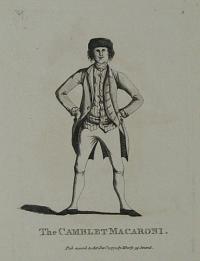
The Camblet Macaroni.
Pub. accord. to Act. Decr. 2. 1772. by MDarly 39 Strand.
Etching, 175 x 125mm. 7 x 5".
Full-face portrait of a young man standing with hands on hips, legs astride. He is not dressed in the macaroni manner, but wears a round cap of camblet, beneath which his own hair appears; he wears a plain coat and neck cloth, with a striped waistcoat. Camblet or Camlet was a rich woven fabric of Asiatic origin believed to have been made of camel's hair or angora wool. From 'Caricatures, Macaronies & Characters, published by MDarly', in an album of caricatures published by Mary Darly dated January 1776. It seems that her husband Matthew made the plates. Numbered 'V5' upper left and '3' upper right. BM Satires: 5040.
[Ref: 14316] £160.00
(£192.00 incl.VAT)
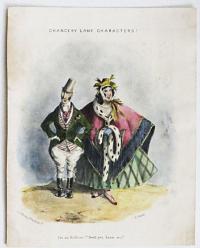
Chancery Lane Characters! I'm an Hofficer!!! Don't you know me?
H. Heath.
I.B Brookes 9 New Bond St. [London, n.d., c. 1830.]
Hand coloured lithograph, sheet 210 x 170mm. 8¼ x 6¾". A little trimmed; good early colour.
An overdressed cockney couple; a social satire on the pretensions of London 'types'. Presumably from a series of popular caricatures. I.(or J.)B. Brookes (1830 - 1837; fl.) published his own lithographic satires. BM Satires undescribed.
[Ref: 27933] £95.00
(£114.00 incl.VAT)
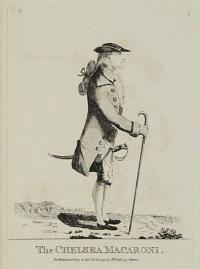
The Chelsea Macaroni.
Published according to Act, Octr. 10, 1772. by MDarly, 39, Strand.
Etching, 175 x 125mm. 7 x 5".
A man in profile with hat, sword, and walking stick. From 'Caricatures, Macaronies & Characters, published by MDarly', in an album of caricatures published by Mary Darly dated January 1776. It seems that her husband Matthew made the plates. Numbered 'V5' upper left and '1' upper right. BM Satires: 4658.
[Ref: 14290] £160.00
(£192.00 incl.VAT)
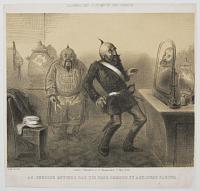
Manners and Customs of the Chinese. An English Officer Has His Hair Dressed by a Chinese Barber.
Smith, Del et Lith.
London, Published at 26, Haymarket, 3 May 1858.
Rare tinted lithograph. Trimmed. Creasing in title.
A comic scene showing the shock of an English officer once he realises that his Chinese barber has styled his hair in the Chinese fashion.
[Ref: 48763] £190.00
(£228.00 incl.VAT)
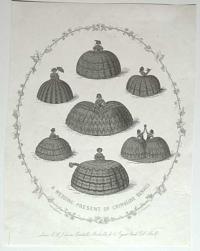
A Wedding Present Of Crinoline Service.
Lithographed by C.J. Culliford.
London, W. H. J. Carter, printseller, Bookseller, &c. 12, Regent Street, Pall Mall. [n.d. c.1850]
Very scarce lithograph, sheet 300 x 230mm (11¾ x 9"). Repaired tears.
A highly decorative satire on crinoline fashion, featuring 8 women in absolutely enormous skirts surrounded by an oval leaf border. W.H.J. Carter made a number of satires on crinoline publishing them annually. See also references 15161, 15159, 15153, 15154, 13109, 15160, 15165, 36835, 36836, 15352, 15353, 15354, 16831 & 42021.
[Ref: 61509] £180.00
(£216.00 incl.VAT)
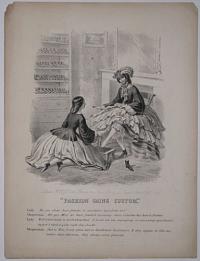
'Fashion Gains Custom.'
London W.H.J. Carter, Printseller, Bookseller &c. 12, Regent Street, Pall Mall.
Lithograph, sheet 380 x 285mm. 15 x 11¼". Facsimile mss. publisher's price list to verso, for '...Prints, Illustrative of Crinoline...beautifully coloured'.
A satire on the mid 19th century fashion for crinolines, from an annual series on that theme by the same publisher. A discussion in a shoe emporium between a fashionable young lady and the female shop assistant reveals a newly instigated policy that male assistants should not serve female customers, 'Since crinoline has been in fashion'. Crinoline was originally a stiff fabric with a weft of horse-hair and a warp of cotton or linen thread. The fabric first appeared around 1830, but by 1850 the word had come to mean a stiffened petticoat or rigid skirt-shaped structure of steel designed to support the skirts of a woman’s dress in the required shape. The crinoline was the subject of much ridicule and satire, particularly in Punch magazine. Dress reformers did not like it either — they seized upon the cage aspect of the crinoline and claimed that it effectively imprisoned women. Given that the crinoline did eventually have a maximum diameter of up to 180 centimetres (six feet), it is easy to imagine difficulties in getting through doors, in and out of carriages, and the general problems of moving in such a large structure. The second problem was the potential impropriety of the crinoline. Its lightness was a curse as well as a blessing, as a gust of wind or a knock could set it swinging and reveal the wearer's legs. Even worse, if a woman tripped or was knocked over, the crinoline would hold her skirts up.
[Ref: 15161] £180.00
(£216.00 incl.VAT)
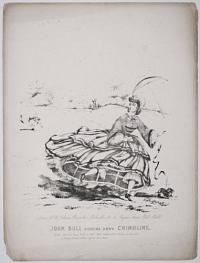
John Bull Running Down Crinoline.
London W.H.J. Carter, Printseller, Bookseller &c. 12, Regent Street Pall Mall.
Lithograph, sheet 380 x 285mm. 15 x 11¼". Tatty extremities, some spotting.
A satire on the mid 19th century fashion for crinolines, from an annual series on that theme by the same publisher. A lady and her toy spaniel (attempt to) run from a charging bull, her parasol falling from her hands. Crinoline was originally a stiff fabric with a weft of horse-hair and a warp of cotton or linen thread. The fabric first appeared around 1830, but by 1850 the word had come to mean a stiffened petticoat or rigid skirt-shaped structure of steel designed to support the skirts of a woman’s dress in the required shape. The crinoline was the subject of much ridicule and satire, particularly in Punch magazine. Dress reformers did not like it either — they seized upon the cage aspect of the crinoline and claimed that it effectively imprisoned women. Given that the crinoline did eventually have a maximum diameter of up to 180 centimetres (six feet), it is easy to imagine difficulties in getting through doors, in and out of carriages, and the general problems of moving in such a large structure. The second problem was the potential impropriety of the crinoline. Its lightness was a curse as well as a blessing, as a gust of wind or a knock could set it swinging and reveal the wearer's legs. Even worse, if a woman tripped or was knocked over, the crinoline would hold her skirts up.
[Ref: 15159] £160.00
(£192.00 incl.VAT)
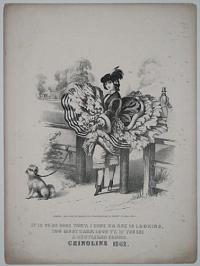
It is to be done Tiney; I hope no one is looking, You must bark loud Ty, If you see a Gentleman coming. Crinoline 1862.
London_W.H.J. Carter, Bookseller, Printseller, &c., 12, Regent St. Pall Mall.
Lithograph, sheet 380 x 280mm. 15 x 11".
A satire on the mid 19th century fashion for crinolines, from an annual series on that theme by the same publisher. A gust of wind lifts up the skirt of a young lady, revealing her underwear, to the evident delight of a gentleman on the path behind her. The lady's dog looks disgruntled, tethered to a fence. Crinoline was originally a stiff fabric with a weft of horse-hair and a warp of cotton or linen thread. The fabric first appeared around 1830, but by 1850 the word had come to mean a stiffened petticoat or rigid skirt-shaped structure of steel designed to support the skirts of a woman’s dress in the required shape. The crinoline was the subject of much ridicule and satire, particularly in Punch magazine. Dress reformers did not like it either — they seized upon the cage aspect of the crinoline and claimed that it effectively imprisoned women. Given that the crinoline did eventually have a maximum diameter of up to 180 centimetres (six feet), it is easy to imagine difficulties in getting through doors, in and out of carriages, and the general problems of moving in such a large structure. The second problem was the potential impropriety of the crinoline. Its lightness was a curse as well as a blessing, as a gust of wind or a knock could set it swinging and reveal the wearer's legs. Even worse, if a woman tripped or was knocked over, the crinoline would hold her skirts up.
[Ref: 15153] £140.00
(£168.00 incl.VAT)
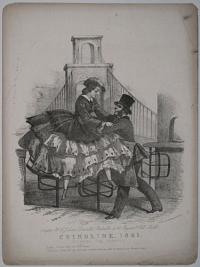
Crinoline 1861. Clearing the Barrier.
London W.H.J. Carter, Printseller, Bookseller, &c. 12, Regent St. Pall Mall. Printed at 22, Southampton St. Strand.
Lithograph, sheet 380 x 285mm. 15 x 11¼". Facsimile mss. publisher's price list to verso, for '...Prints, Illustrative of Crinoline...beautifully coloured'. Tatty extremities, creases through upper corners.
A satire on the mid 19th century fashion for crinolines, from an annual series on that theme by the same publisher. A lady is helped over turnstiles by a gentleman, a bridge, maybe Hammersmith Bridge, in the background. Crinoline was originally a stiff fabric with a weft of horse-hair and a warp of cotton or linen thread. The fabric first appeared around 1830, but by 1850 the word had come to mean a stiffened petticoat or rigid skirt-shaped structure of steel designed to support the skirts of a woman’s dress in the required shape. The crinoline was the subject of much ridicule and satire, particularly in Punch magazine. Dress reformers did not like it either — they seized upon the cage aspect of the crinoline and claimed that it effectively imprisoned women. Given that the crinoline did eventually have a maximum diameter of up to 180 centimetres (six feet), it is easy to imagine difficulties in getting through doors, in and out of carriages, and the general problems of moving in such a large structure. The second problem was the potential impropriety of the crinoline. Its lightness was a curse as well as a blessing, as a gust of wind or a knock could set it swinging and reveal the wearer's legs. Even worse, if a woman tripped or was knocked over, the crinoline would hold her skirts up.
[Ref: 15154] £180.00
(£216.00 incl.VAT)
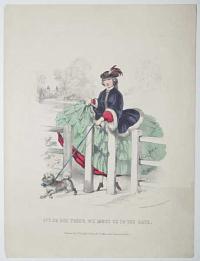
It's no use Tiney, we must go to the gate.
Lithographed by C.J. Culliford, 22, Southampton S.t Strand.
Published Nov.r 11.th by Mess.rs Fielding & C.o. 5, Melton Street, Euston Squ.e. London. [n.d. c.1858.]
Coloured lithograph, 380 x 285mm (15 x 11¼").
A satire on the mid 19th century fashion for crinolines. A woman walking her small dog is blocked by her crinoline dress going through a small passage in a fence.
[Ref: 60113] £140.00
(£168.00 incl.VAT)
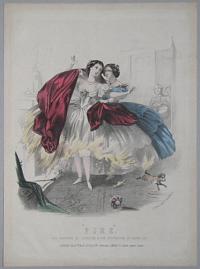
"Fire." The Horrors of Crinoline & the Destruction on Human Life.
L'Enfant, Imp, 18, Rathbone Pl.
Published the 14th. April. 1859 by, F.W. Farbrother, 5, Milton St. Euston Square, London.
Fine original hand coloured lithograph, sheet 375 x 275mm. 14¾ x 10¾".
A satire on mid 19th century female fashion; a young lady's dress has caught fire in an interior. Her terrier flees the scene with its tail on fire, an anxious servant with a bucket of water appears at a door in the background. Crinoline was originally a stiff fabric with a weft of horse-hair and a wrap of cotton or linen thread. The fabric first appeared around 1830, but by 1850 the word had come to mean a stiffened petticoat or rigid skirt-shaped structure of steel designed to support the skirts of a woman’s dress in the required shape. The crinoline was the subject of much ridicule and satire, particularly in Punch magazine. Dress reformers did not like it either — they seized upon the cage aspect of the crinoline and claimed that it effectively imprisoned women. Given that the crinoline did eventually have a maximum diameter of up to 180 centimetres (six feet), it is easy to imagine difficulties in getting through doors, in and out of carriages, and the general problems of moving in such a large structure. The second problem was the potential impropriety of the crinoline. Its lightness was a curse as well as a blessing, as a gust of wind or a knock could set it swinging and reveal the wearer's legs. Even worse, if a woman tripped or was knocked over, the crinoline would hold her skirts up.
[Ref: 13108] £130.00
(£156.00 incl.VAT)
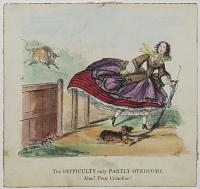
The Diddiculty only Partly Overcome. Alas! Poor Crinoline!
[n.d., c.1840.]
Lithograph with hand colour. Sheet 125 x 130mm (5 x 5¼"). Stain in title.
A woman escaping a bull catches her skirt. Her toy dog looks petrified.
[Ref: 51827] £65.00
(£78.00 incl.VAT)
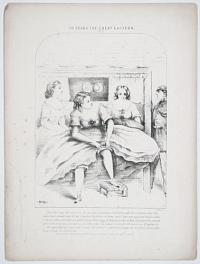
"On Board the Great Eastern" No. 3. But that aint the worst of it; the doors are all painted so beautiful, and look so romantic, that they didn't like to number them...
SEM-
London W.H.J. Carter, Printseller, Bookseller &c. 12, Regent Street, Pall Mall. [n.d., c.1860.]
Lithograph. Printed area 310 x 200mm, 12¼ x 8". Some wear and soiling.
[Ref: 15354] £180.00
(£216.00 incl.VAT)
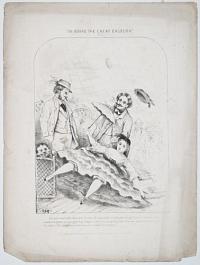
"On Board the Great Eastern" No. 2. You aint much better off on deck, for when the ship pitches or rolls, you are apt to lose your stool...
SEM-
London W.H.J. Carter, Printseller, Bookseller &c. 12, Regent Street, Pall Mall. [n.d., c.1860.]
Lithograph. Printed area 310 x 200mm, 12¼ x 8". Some wear and soiling.
A satire on crinolines on luxury passenger ships, with a woman keeling over, to the amusement of the watching men. With a catalogue of crinoline satires available from Carter on verso. Brunel's Great Eastern was launched in 1858, but was damaged by an explosion on her maiden voyage. After only a half-dozen years as a passenger ship she was converted to a cable-laying ship, laying the first lasting transatlantic telegraph cable in 1866.
[Ref: 15353] £180.00
(£216.00 incl.VAT)
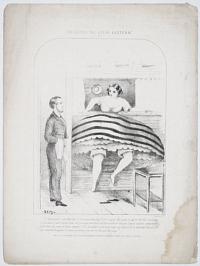
"On Board the Great Eastern" No. 1. To dismount is another feat of horsemanship only fit for a sailor...
SEM-
London W.H.J. Carter, Printseller, Bookseller &c. 12, Regent Street, Pall Mall. [n.d., c.1860.]
Lithograph. Printed area 310 x 200mm, 12¼ x 8". Some wear and soiling.
A satire on crinolines in the confines of luxury passenger accommodation, with a woman climbing down from a bunk, watched by a steward. With a catalogue of crinoline satires available from Carter on verso. Brunel's Great Eastern was launched in 1858, but was damaged by an explosion on her maiden voyage. After only a half-dozen years as a passenger ship she was converted to a cable-laying ship, laying the first lasting transatlantic telegraph cable in 1866.
[Ref: 15352] £180.00
(£216.00 incl.VAT)
![[Seven vignette satires of bonnets on one sheet.]](img-thumbnail/jpegs/57292.jpg)
[Seven vignette satires of bonnets on one sheet.]
Drawn Etched & Published by George Cruikshank ~
May 20th 1829.
Etching with hand colour. Sheet 255 x 365mm (10 x 14½"). Spotting.
Seven satires on ladies' hats, including: 'Bonnet Building', featuring four milliners, two on tall step-ladders, trimming a hat far larger than themselves with giant bows of ribbon; and 'Section of the Bonnet Carriage', depicting a carriage shaped accomodate her hat and her bustle. From the series 'Scraps and Sketches'.
[Ref: 57292] £260.00
(£312.00 incl.VAT)
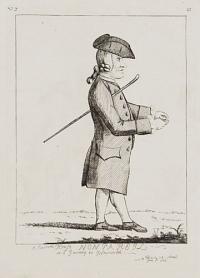
A Custom House Non Pareil on a Journey to Isleworth.
Pub by MDarly 39 - Strand June 3 1774.
Etching with very large margins, 18th century watermarked paper; 245 x 175mm. 9¾ x 7".
A man walking in profile with his cane tucked under his arm; he appears to be holding a coin out in front of him. From an album of caricatures published by Mary Darly dated January 1776. It seems that her husband Matthew made the plates. BM Satires: undescribed.
[Ref: 32474] £220.00
(£264.00 incl.VAT)
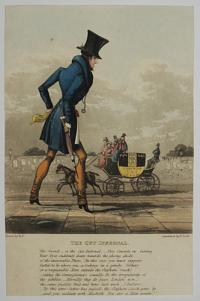
The Cut Infernal. ''The Second_is the Cut Infernal._This Consists in Casting...'
Drawn by M.E. Aquatinted by H. Pyall.
[London. Pub.d by Tho.s McLean, 26, Haymarket. 1827.]
Hand-coloured aquatint. Sheet: 305 x 195mm (12 x 7¾''). Trimmed.
A satirical scene showing a well-dressed dandy walking along the street avoiding puddles. In the background a carriage labelled 'Clapham to London' drives by and a man on the carriage yells towards the dandy. One of a set of three, the other two are: 'The cut celestial', and 'The cut direct!' BM Satire 15484.
[Ref: 49314] £120.00
(£144.00 incl.VAT)
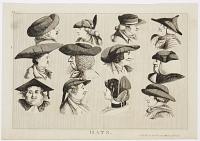
Hats.
Pubd. Accorg. to Act Octr. 1. 1773 by MDarly 39 Strand.
Etching, 18th century watermark, platemark 250 x 350mm (9¾ x 13¾"); large margins on 3 sides.
Twelve caricature heads showing the different types of hat worn by men. A companion print to 'Wigs' (ref. 43828). From an album of caricatures published by Mary Darly dated January 1776. It seems that her husband Matthew made the plates. BM Satires: 5169.
[Ref: 43827] £290.00
(£348.00 incl.VAT)
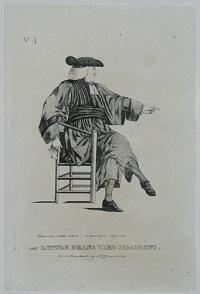
The Little Deans Yard Macaroni. V.4. 2. Sanguineos oculos volvit, virgamque requirit.
Pub by MDarly Strand July 30th. 1772 accor to Act.
Etching. Plate 172 x 120mm. 6¾ x 4¾". Mount burn, paper toning.
Dr Samuel Smith, Headmaster of Westminster School, seated in a chair. He looks in profile to the right and points with his left hand, the other hangs over the arm of the chair holding a glove. He wears a flat three-cornered hat, a short tightly curled wig, a pair of bands, and a voluminous gown. 'Sanguineos oculos volvit, virgamque requirit' inscribed above title. From 'Macaronies, Characters, Caricatures &c by MDarly', in an album of caricatures published by Mary Darly dated January 1776. It seems that her husband Matthew made the plates. Numbered 'V.4' upper left and '2' upper right. BM Satires: 5021.
[Ref: 21228] £180.00
(£216.00 incl.VAT)
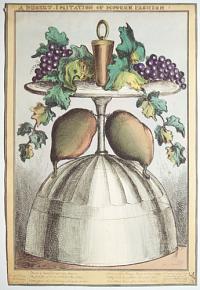
A desert - imitation of modern fashion!
[Monogram of Paul Pry, pseudonym of William Heath]
Pub by T. McLean 26 Haymarket London [n.d., c.1825].
Fine coloured etching. Sheet 355 x 240mm (14 x 9½"). Trimmed into printed border.
An upturned wine glass represents a woman, with the rim the brim of a hat with grapes as decoration, the bowl her bustle. BM Satires 15611.
[Ref: 58276] £260.00
(£312.00 incl.VAT)
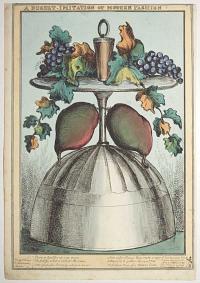
A Desert - Imitation of Modern Fashion!
[Monogram of Paul Pry, pseudonym of William Heath, holding a wine glass]
Pub by T. McLean 26 Haymarket London [n.d., c.1825].
Etching with fine hand colour. Sheet 365 x 255mm (14¼ x 10"). Trimmed into plate on three sides, to printed border at top.
An upturned wine glass represents a woman, with the brim of a hat with grapes as decoration, the bowl her bustle. BM Satires 15611.
[Ref: 59479] £320.00
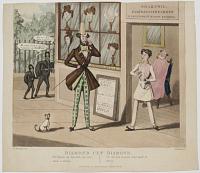
Diamond Cut Diamond. Oh Wigsby my boy, did you ever shave a Monkey. [/] No Sir, but if you'll just walk in I'll try.
W. Summers, Del. Cha.s Hunt, Sc.
London, Pub by Harrison Isaacs, Charles St. Soho. [n.d., c.1830.]
Hand coloured aquatint with etching. Sheet size: 235 x 270mm (9¼ x 10½"), watermarked paper, 'J. Whatman. 1830'. Trimmed inside plate and to image at top edge.
A scene outside 'Sharpwig, Hairdresser & Shaver', as an elaborately dressed figure inspects the shop through his monicle. The hairdresser stands in the doorway, holding shaving equipment, laughing, as does the customer inside. An advertising sign outside the shop reads, 'Theatre Royal Covent Garden [...] Barber of Seville [...] The Monkey that has seen the World'. The shop window displays various wigs and, to the left, two chimneys sweeps look on, with one saying, 'My eyes Jem theres a swell cove', the other replies, 'Ah! What a lark it would be to send him up a Gas Pipe'. Hickman p.139.
[Ref: 36664] £230.00
(£276.00 incl.VAT)
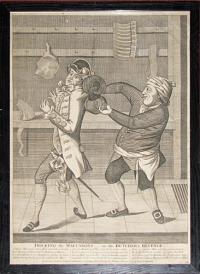
Docking the Maccaroni__of the Butcher's Revenge. A Spruce Maccaroni who Hair and whose Cloaths, Were the envy of Fops, and the Patterns of Beaus...Now Now cry'd the Butcher the People may stare, At a Skull without Brains, & a Head without Hair.
Printed for & Sold by Carington Bowles, at his Map & Print Warehouse, No.69 in St. Pauls Church Yard, London. 91. Published
Engraving, framed. 521 x 368mm. 20½ x 14½". Some paper damage in the title area.
Satire on fashion, with a butcher cutting off the back of a Macaroni's club. BM Satires: 4527. ex Blackburn Collection.
[Ref: 17743] £650.00
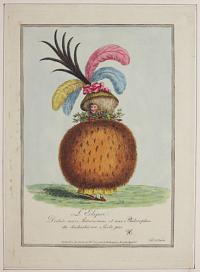
L'Eclipse. Dediée aux Astronomes, et aux Philosophes du dixhuitieme Steele par VA.
Etch'd by J. Barlow.
Publish'd as the Act directs, Feb.y 20, 1787, by H. Humphrey No 51, New Bond Street.
Rare etching with fine hand colour. 300 x 215mm (12 x 8½"). Mounted in album paper.
A woman's head, topped with a conical hat trimmed with a monstrous arrangement of feathers, peers over a huge fur muff. Eclipses were in the news in 1787 because there were seven full eclipses of the sun and moon, the maximum number possible, which usually happens once every 130 years. A note on the British Museum's example of this print (from the Banks Collection) ascribes it to a Miss V. Aynscombe. BM Satires 7248. The three examples in the BM are all uncoloured.
[Ref: 43889] £480.00
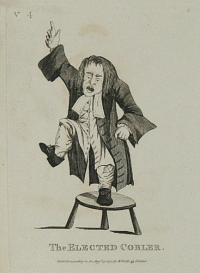
The Elected Cobler.
Publish'd according to Act Augt. 27. 1772 by MDarly, 39 Strand.
Etching, 170 x 125mm. 6¾ x 5".
A man in a long coat standing on a three-legged stool ranting, one foot raised and one arm in the air. From 'Macaronies, Characters, Caricatures &c by MDarly', in an album of caricatures published by Mary Darly dated January 1776. It seems that her husband Matthew made the plates. Numbered 'V.4' upper left and '10' upper right. BM Satires: 4709.
[Ref: 14243] £160.00
(£192.00 incl.VAT)
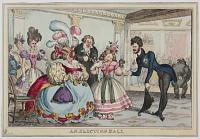
An. Election. Ball.
[Paul Pry] Esq. Del.
London Published by McLean, 26 Haymarket. [n.d., c.1829].
Hand-coloured etching. Sheet size: 245 x 355mm (9¾x 14"). Trimmed.
An interior view in which a well dressed dandy bows and takes the hand of the plain daughter of a grotesquely fat mother, to the shock and confusion of the guests behind. The ballroom can be seen through an open facade in the background. By William Heath (1794/5-1840) ex-Captain of Dragoons, illustrator of colour-plate books, and prolific caricaturist. He published regularly with Thomas McLean. Not in BM Satires.
[Ref: 32033] £260.00
(£312.00 incl.VAT)
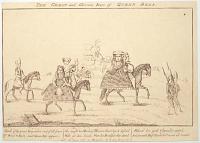
The Great and Glorious days of Queen Bess.
Agnes T_n. [Townshend?]
Pub.d 30th June 1781 by H.Humphrey, No 18 New Bond Street.
Engraving. Sheet 180 x 255mm (7 x 10"). Trimmed to platemark.
A satire on Elizabethan dress, probably a companion print to one satirising the fashion of 1781. It has been suggested that the artist was Agnes Townshend, a noted courtesan. BM: 5937 (and see 5936).
[Ref: 54354] £260.00
(£312.00 incl.VAT)
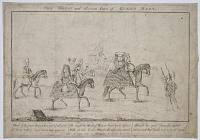
The Great and Glorious days of Queen Bess.
Agnes T_n. [Townshend?]
Pub.d 30th June 1781 by H.Humphrey, No 18 New Bond Street.
Engraving. 185 x 270mm (7¼ x 6¾") Creased, some soiling.
A satire on Elizabethan dress, probably a companion print to one satirising the fashion of 1781. It has been suggested that the artist was Agnes Townshend, a noted courtesan. BM: 5937 (and see 5936).
[Ref: 6849] £75.00
(£90.00 incl.VAT)
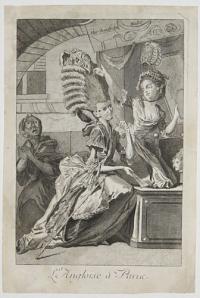
L'Angloise à Paris.
[n.d., c.1770.]
Engraving. Sheet: 270 x 405mm (10½ x 16"). Trimmed. Small margins, cut to plate at bottom. Some restoration.
A plain looking woman sits trying on wigs in a 'Marchande de Modes' behind a bespectacled woman looks on aghast. French copy of an English print!
[Ref: 44264] £260.00
(£312.00 incl.VAT)

His Grace of __ a Specimen of English Nobility. see the last Number, p.22. Designed & Engraved for the London Museum
[London Magazine, August 1771.]
Etching. 170 x 110mm (6¾ x 4¼"). Trimmed to plate at sides, mounted in album paper.
A caricature of a young man of fashion at the races. According to the text (not present here), ''See them all the morning nobly emulating to look like the miserable French friseurs, who are continually trotting the streets with their scanty coats...''.
[Ref: 52640] £75.00
(£90.00 incl.VAT)
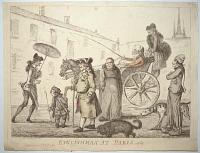
Englishman at Paris. 1767.
Mr. Bunbury del. J.s Bretherton f.
Publish'd 23d Feb.y 1782.
Etching, with partial hand colour. 330 x 410mm (13 x 16"). Trimmed to plate top and bottom, tear entering image at top.
A satire contrasting English and French styles of dress. A stout middle-aged Englishman wears a heavy coat and three-cornered hat and carrying a stick, amusing the passers-by with his lack of elegance. These include: a hairdresser wearing his hair in a large queue, carring a parasol'; a grinning fat monk; and an elegant man driving a cabriolet, with his footman dressed in furs. BM Satires 4185.
[Ref: 54323] £260.00
(£312.00 incl.VAT)
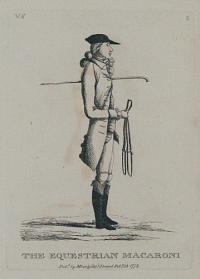
The Equestrian Macaroni.
Pubd by MDarly (39) Strand Feby 13 1773.
Etching, 175 x 125mm. 7 x 5".
A man in riding costume in profile, holding a bridle, a crop under his left arm. He wears a small looped club, a low hat, plain coat, striped waistcoat, and spurred riding boots. Racing interest. From 'Characters, Macaronies & Caricatures, by MDarly', in an album of caricatures published by Mary Darly dated January 1776. It seems that her husband Matthew made the plates. Numbered 'V.6' upper left and '3' upper right. BM Satires: 5150.
[Ref: 14493] £170.00
(£204.00 incl.VAT)
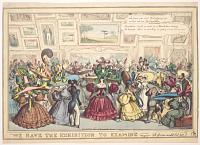
''We have the exhibition to examine"
[William Heath.]
Pub. by T. McLean 26 Haymarket London.
Hand-coloured etching. Sheet 255 x 355mm (10 x 14''). Cut to borders. Some repaired nicks to edges.
A scene in an exhibition salon in which specatators struggle to see the paintings through the large crowd and enormous hats. One disgruntled man wipes his head in exasperation after his daughter tries to disuade him from leaving.
[Ref: 56453] £320.00
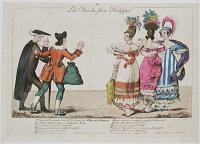
Les Oies du Frére Philippe.
à Paris, Chez Gautier, rue Poupée, No. 7. Depose a la Direction G.le de l'Imp. [n.d., c.1813.]
Coloured etching. 225 x 320mm (9 x 12½"). Creased in centre.
A scene from one of Jean de la Fontaine's fables: Philippe, who, in dedication to God, retired to a mountain cave where his son grew up free from temptation. When, at age twenty, the youth emerged, Philippe truthfully explained to him all that he saw until they came to a party of young women. 'What is that?' asked the youth. 'A party of geese', his father replied. 'Father, I beg you, let us take one with us.'
[Ref: 32696] £150.00
(£180.00 incl.VAT)
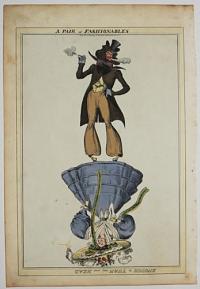
A Pair of Fashionables. Enough to Turn any one's Head.
[William Heath.]
Pub. Oct. 4 1827 by T. McLean Haymarket London.
Hand-coloured etching, 1822 watermark. Plate: 375 x 260mm (14¾ x 10¼''). Foxing at bottom.
An upside down print showing a man and a woman dressed in exaggerated fashions.
[Ref: 50800] £320.00

Bless me what perfect specimens to be sure!!!
I.B. Brooks, 9 New Bond St. H.Heath.
Printed by H.Lefebre & Kohler, 52 Newman St. [n.d., c.1840.]
Coloured lithograph. 230 x 170mm.
Women gathering around a monkey house. Not in BM.
[Ref: 3125] £130.00
(£156.00 incl.VAT)
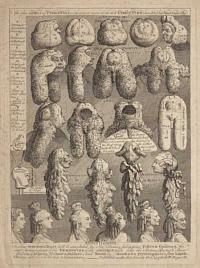
The five orders of Perriwigs as they were worn at the late Coronation, measured Architectomically.
Publish'd as the Act directs Oct.r 13, 1761 by W.Hogarth.
Copper engraving, plate 300 x 22mm, (12 x 8¾"). Later issue. Foxed. Paper toned. Tears to margins taped.
Hogarth's famous satire on wigs, attempting to define styles in the same way that Vitruvius had categorised architecture, published shortly after the coronation of George III. At the bottom of the engraving is an 'Advertisement' stating that a series of six folio volumes published over 17 years will set out the measurements of the periwigs of the ancients; this satirises Stuart's Antiquities of Athens. BM Satires 3812; Paulson state III of III, with 'or Parsonic' added and the 'e' of 'Advertisement' added above the line.
[Ref: 61963] £230.00
(£276.00 incl.VAT)
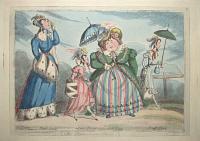
The Four -- Prices. High Price. Low Price. Full Price. Half Price.
[William Heath?]
London Published Jan.y 26 1825 by S.W. Fores Piccadilly [but later].
Coloured etching. 250 x 355mm (9¾ x 14"), very large margins.
Four fashionably dressed women promenade, probably in Hyde Park. One is tall, the others short, fat and thin. BM Satires 14902, in imitation of 14901. See Ref: 58270
[Ref: 58294] £280.00
(£336.00 incl.VAT)
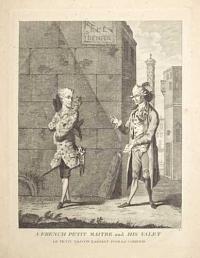
A French Petit Maitre and His Valet. Le Petit Gascon Partant pour la Comedie.
[after Charles Brandoin.]
[n.d., c. 1755.]
Very rare etching. 365 x 260mm (14¼ x 10¼"), with large margins. Stitch holes in left edge. Slightly time-stained.
A scene on Rue d'Enfer, a Parisian street, with a foppish Frenchman wearing a coat decorated with hearts, a large nosegay on his shoulder and ribbons on his sword. His valet, who has a comb in his curl-papers, holds out a paper inscribed ''Au petit Marquis''. A close copy of a plate by Charles Grignion, published by Robert Sayer and John Smith in 1771, with the French title added. See BM Satires 4933 for the original.
[Ref: 60765] £360.00
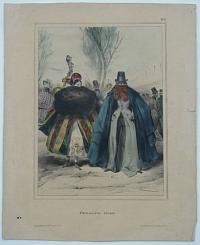
Phenomene vivant. No.6.
Numo [signed in plate.] Lith. de Bernard, rue de l'Abbaye No.4.
Paris, chez Ledoyen, rue St. Jacques No.21. [n.d., c.1850.]
Hand coloured lithograph, sheet 335 x 275mm. 13¼ x 10¾". Small tears to extremities.
A young French woman walking in the street, a brightly coloured cloak covering her floral dress and a huge muff partially obscuring her face; she is accompanied by a man in top hat and long coat whose face is covered. For a series of caricatures following the activities of a young ballerina/singer or stage prodigy.
[Ref: 19535] £85.00
(£102.00 incl.VAT)
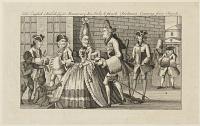
The English Frenchifyed Macaroney, his Lady & french Footman Comeing from Church.
[n.d., c. 1770.]
Engraving. Plate: 100 x 175mm (4 x 7") large margins. Laid on album sheet.
A comic scene showing a man and his wife, dressed in the highly decorative French fashions, walking from church while other people in the street stop and stare.
[Ref: 43965] £70.00
(£84.00 incl.VAT)
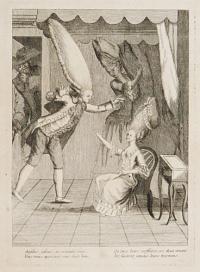
Anglois jaloux, ne craignés rien; / Vous vous apercevés sans doute bien./ Qu'avec leurs ceffures. Ces deux amours ne finement jamais leurs tourmens
[French, c.1775.]
Etching, rare with very large margins. 290 x 190mm (11½ x 7½"). Paper lightly toned, folds in margins.
Satire on the incompatability of romance with big hair. An elaborately-dressed couple, with swept-up hair, the man with a lapdog under his arm. Ex Collection of the Hon Christopher Lennox-Boyd.
[Ref: 31748] £320.00
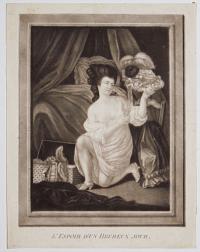
L'Espoir d'un Heureux Jour.
[n.d., c.1780.]
French mezzotint. Sheet: 295 x 225mm (11½ x 8¾''). Trimmed.
A scene in a room showing a young woman, deshabille, looking through her things. She lifts up her ornate hat. The title translates as 'The hope of a good day'.
[Ref: 48843] £190.00
(£228.00 incl.VAT)
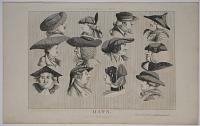
Hats.
Pubd. Accorg. to Act Octr. 1. 1773 by MDarly 39 Strand.
Etching, 245 x 350mm. 9¾ x 13¾".
Twelve caricature heads showing the different types of hat worn by men. A companion print to 'Wigs' (item 14113). From an album of caricatures published by Mary Darly dated January 1776. It seems that her husband Matthew made the plates. BM Satires: 5169.
[Ref: 14112] £420.00
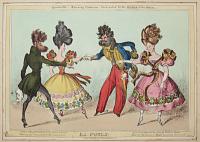
Quadrille - Evening Fashions - Dedicated to the Heads of the Nation. La Poule.
[Monogram of Paul Pry.][William Heath.]
London, Published by Thos. McLean, 26 Haymarket 1827.
Hand-coloured etching. Watermark: J.Whatman Turkey Mill 1826. Sheet size: 245 x 365mm (9¾ x 14¼"). Trimmed and mounted in album sheet.
Two couples with exaggerated, absurd hairstyles and fashionable dress, dancing. Drawn and etched by satirical printmaker, William Heath (1794 - 1840). Not in BM Satires.
[Ref: 46644] £160.00
(£192.00 incl.VAT)



![[Fashions of Brighton.]](img-thumbnail/jpegs/43972.jpg)















![[Seven vignette satires of bonnets on one sheet.]](img-thumbnail/jpegs/57292.jpg)





























